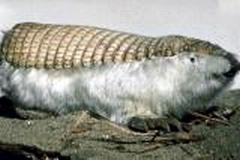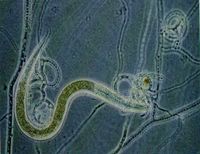Thursday, March 31, 2005
Blogger is weird!
Read more!
Grrr!
work was unusually bad, several of the people I supervise were acting like irresponsible twits, had to stay an hour late for a last minute document imaging project. Got home, tried to upload my pictures for Friday critter blogging and couldn't get logged in via Hello. Hopefully I will get it straightened out before the weekend becuase I have a large post planned.
Read more!
Imax: Part VII
Jackie: jmollet@slsc.org
Brad: bnuccio@slsc.org
at the St. Louis Science Center. Has anybody else heard from them?
Read more!
Wednesday, March 30, 2005
A great article on creationism
An excerpt to hold you over till you get there:
"The backlash against the theory of evolution (and the teaching of it) resonated not only with religious fundamentalists, but also with political and economic populists. Faced with the near impossibility of changing economic and political power structures, many turned their attention to the alleged evils of a secular society."
and:
"As we follow in the months ahead what is being called the Scopes II trial out of the Dover Area School District, it will be worth our while to consider why we're at it again, what other parallels we might draw between the Gilded Age and today, and whose interests are really being served here."
Read more!
Busy
Read more!
BLOGGER weirdness
Added later:Apparently whatever was ailing blogging has been cleared up.
Read more!
Tuesday, March 29, 2005
A Systematic Classification of Creationists!
Read more!
Some Politics
(ADDED LATER): Kevin Drum has a link to this interesting study of Texas malpractice awards.
On an unrelated note, back around christmas time there were a bunch of stories about the atack on christmas and about how evil the ACLU is for attacking religion. Here is a link to what the ACLU really thinks about religion!
Read more!
Heritage Foundation goes Creationist
Read more!
2.5 Billion Year Old Sulpher Eating Bactera?


According to a story in today's St. Louis Post-Dispatch the above picture is of fossils dating to 2.5 billion years ago. It was found in China, by a geologist affiliated with St. Louis University, in what is believed to be the geological remnants of a black smoker chimney.
Read more!
Okay, Where the &^%$@# is Mine?
Read more!
Monday, March 28, 2005
Imax: Part VI
Please feel free to contact Jackie Mollet, OMNIMAX manager or Brad Nuccio,
VP of Sales/Marketing since both of them make decisions on the films.
Thanks!
Jackie: jmollet@slsc.org
Brad: bnuccio@slsc.org
Read more!
Sunday, March 27, 2005
Homo floresiensis
A second article, by Josh Fischman, covers finds of Homo erctus at Dmanisi, Georga. The main emphasis of the article is on one of specimens that was toothless. More importantly, the mandible shows signs of bone resorption - indicating the individual survived after loosing his teeth. In this respect this find is similar to finds of later neanderthals. The author also discuss the spread of H. erectus out of Africa, and of course, links it to the H. floresiensis finds. One of the more interesting pieces of information in the article is that the Dmanisi fossils were smaller than the african or asian erectus specimens (excepting H. floresiensis). Height is around four and a half feet and cranial capacity averaged 650 cc's. Some traits displayed by the four skulls are similar to H. habilis and one of the discovers, David Lordkianidze, is quoted as saying "... this is something between habilus and erectus, and maybe it's the founder of erectus".
Interesting, I really need to get to a library and catch up on whats been happening in the world of Paleoanthropology.
Read more!
Shout Outs and Kudos and Imax
Kudos and Imax: Another commenter here mentioned that since the Ft. Worth Science and History Museum has decided to show the "Volcanoes..." movie he bought a membership. I think this is a great idea. Maybe, if we could go to some of the museums and science centers and promise to purchase a certain number of memberships it might help convince them to show the movie. As mentioned in several other sites, we are the market for museums and science centers and maybe we should use the free market to our advantage. Any takers?
Read more!
Saturday, March 26, 2005
Imax: Part V
"Science Center film sparks vandalism
Vandals splashed red paint and scrawled anti-war slogans on the St. Louis Science Center, which is showing an Omnimax movie about piloting F-15 Eagle fighters, a center spokeswoman said.
She said workers cleaned the walls and cut away part of a movie poster that was defaced with obscenities. The vandalism, discovered early Thursday morning, did about $4,000 in damage.
The movie is called "Fighter Pilot: Operation Red Flag," a reference to the air-war training programs at Nellis Air Force Base near Las Vegas."
Blame is being placed on local peace activists who claim the movie is a propaganda piece financed by the Boeing company. As yet, however there are NO suspects and police are reviewing surveillance tapes.
On an unrelated note, there is a drive afoot to get as many Imax centers as possible to show the movie "Volcanoes of the Deep Sea" It is not on the St. Louis Science Center's Calander as of this post. Perhaps we should call (St. Louis Science Center 314-289-4444) or email the public relations manager -Dorothy Hutchinson-Gross at dhutchin@slsc.org
Red State Rabble has contact info for other Imax theaters around the midwest, and I should mention I got the idea to email the Science Center and recommend they show the film from him. Didn't think of it myself -still suffering brain meltdown.
Read more!
It's All Too MUCH Brain Melting!!
Read more!
Political Compass
Read more!
Friday, March 25, 2005
Friday Bonus Jellyfish Blogging


Jelly fish are kind of interesting and this one is no exception. They eat fish, grom up to 65 mm and can reproduce either sexually or asexually. Couldn't find any interesting info about their evolution. Although they are Cambrian and Post-Cambrian in origin. They are related to sea anemones, corals and sea pens.
Pelagia noctiluna 2


They also glow in the dark. Hence the noctiluna part of their name.
Read more!
Imax: Part IV
Read more!
Friday Fairy Armadillo Blogging
Fairy Armadillo


Fairy armadillo 2


armadillo


For more info go here, here, here, here and here.
Read more!
Thursday, March 24, 2005
My Friday Post Has Been Hijacked!
Carl Zimmer and De Rerum Natura have both written on I subject I was going to post about on Friday. I had found a great article I was going to use to get on the Friday Ark. Allow me to explain. Yesterday, I stumbled across this at New Scientist. It concerns a species of plant called weedy cress. Apparently, weedy cress is able to, somehow, revert to grandparental genotypes. The authors of the paper hypothesize that backup copies of the grandparental genotype are kept in the form of RNA. Fascinating stuff. I was going to post about it - had found som cool links here, here, and here. Oh Well. They are much better writers than I am. Check them out.
Read more!
IMAX: Part III
"We want to ensure that you know the Museum supports the position that evolution is a major unifying concept of science. We use scientific evidence in our wide-ranging presentations and interpretations of how life has changed over time."
Since, they did reverse their decision, I wrote them a letter thanking them. I feel that it is important to support them for, belatedly, coming to the right decision.
Read more!
The Best Essay I Have Read in Quite Awhile
Read more!
Tuesday, March 22, 2005
Imax: Part II
This is the response:
"As stated in our mission, the St. Louis Science Center is dedicated to
"promoting the interest in and understanding of science and technology"
throughout our service area. We plan to continue showing appropriate,
mission-driven films such as our current films "Forces of Nature," which
explores volcanoes, earthquakes and tornadoes and "Fighter Pilot: Operation
Red Flag" which shows the intense training and technical skills and
equipment behind flying an F-15."
You can email the public relations manager (Dorothy Hutchinson-Gross) at dhutchin@slsc.org
Read more!
Monday, March 21, 2005
Eschaton: Part II
"In many areas, the bill reduces Missouri's program to the minimal levels required by federal law. The elderly and disabled could earn no more than 74 percent of the poverty level, or $579 a month for a single person. They currently qualify if they earn no more than the poverty level. " Go here and here for details on medicaid.
On the malpractice front we have the following:
"The thrust of both bills is to reduce the amount of money paid to people who are injured. The bill overhauling the civil justice system would:
Reduce the maximum that could be recovered for pain and suffering to $350,000 from $579,000. The cost-of-living adjustment made to the cap every year is also eliminated.
Require that damage claims be filed in the county where the accident occurred.
Limit punitive damages to $500,000 or five times the amount of actual damages, whichever is greater. Currently there is no limit.
The bill also extends these protections to nursing homes. Lawsuits involving other types of accidents, like automobile collisions and claims about defective products, are also covered by parts of the bill." Go here for more details.
To me the bottom line is that if you are going to talk about valuing the "Culture of Life" you should not then turn around and pass laws that make it impossible for people to live up to those values. In this case the republicans are exploiting a tragedy for politcal ambition.
Read more!
Sunday, March 20, 2005
Thoughts from Kansas and National Geographic
Read more!
Eschaton
Those of us who read liberal blogs are also aware that Republicans have voted en masse to pull the plug (no pun intended) on medicaid funding that pays for the kind of care that someone like Terry Schiavo and many others who are not so severely brain damaged need all across this country.
Those of us who read liberal blogs also understand that that the tort reform that is being contemplated by the Republican congress would preclude malpractice claims like that which has paid for Terry Schiavo's care thus far.
Follow the above link for more.
Read more!
Imax Censors Evolution!
Read more!
Friday, March 18, 2005
Friday Tapeworm Egg Blogging

 Below is a side view of an adult. The rostellum is slightly visible as are the four suckers. Note: apparently in pork tapeworms the rostellum is hooked, whereas, in the beef tapeworm it is not.
Below is a side view of an adult. The rostellum is slightly visible as are the four suckers. Note: apparently in pork tapeworms the rostellum is hooked, whereas, in the beef tapeworm it is not.

Finally a close up of the rostellum and suckers.
;


For more info on tapeworms go to Yucky Tapeworms
Interesting articles about human-tapeworm coevolution:
Here
Here and Here. Incidentally, for the creationist types this last link proves the US government believes in Evolution.
Also, for more cool animals go to The Friday Ark
Read more!
Thursday, March 17, 2005
From: UC Berkeley
Deans' Corner — Unintelligent Designs and the Responsibility of Educators
Robert Holub, Dean of the Undergraduate Division
March 14, 2005
Deans' Corner Archive
Letters & Science is a college of five deans, reflecting the disciplinary scope and diversity of Berkeley's largest school or college. In the "Deans' Corner", they take turns reflecting on topics of current interest. The "Deans' Corner" is a virtual "Op Ed" page, or — if you prefer a concrete metaphor — a Sproul Plaza.
In this contribution, Undergraduate Division Dean Robert Holub discusses 'intelligent design' and the responsibility of educators to promote scientific literacy.
At a recent academic cocktail party I had the occasion to speak with two colleagues, both fellow humanists, about various topics in higher education. At one point the conversation turned to the notion of intelligent design, and much to my amazement both colleagues indicated a great deal of sympathy for this alternative to "Darwinism." I was shocked, and although I told them that few, if any, reputable biologists in the country subscribe to intelligent design, I could tell that they were not persuaded. Somewhat dismayed, I turned to other, more congenial issues.
That even intelligent people fall for intelligent design was disquieting. I had read the news stories describing the large numbers of people who believe that intelligent design should be taught along side Darwin's theory of natural selection, and the somewhat smaller, but more alarming group that advocates creationism or intelligent design be taught instead of Darwinism. But until that conversation with my colleagues I thought that misconceptions about evolution were a phenomenon of communities far away from Berkeley, not members of faculty of the most distinguished university in the country.
Above all I used to believe that controversies around Darwin involving genuine intellectuals belonged to the historical past. Indeed, in the decades following the initial publication of the Origin of the Species in 1859 many leading scientists took exception to the notion of natural selection and substituted something involving "design" as an alternative.
Karl Ernst von Baer, for example, a renowned zoologist whom Darwin himself lauds in the Origin of the Species, granted partial validity to natural selection, but found that there were too many questions left unanswered by a theory that relied on chance variation and required enormous spans of time for the realization of species development. In a book from 1876 von Baer lists five questions for Darwinian theory, all of which are fairly typical for the thought of his contemporaries, and which have resurfaced in some form in many discussions today. First, with regard to the creation of the first organism, from which all other organisms then develop, de Baer asks why it must occur only once? Second, if one species gradually transforms itself into another, why do we not find a wealth of transitional stages? Third, if there are deviations in one generation, why would they not revert to the norm when they procreate with the non-deviant population? Fourth, how can Darwin explain the relative stability of species? According to his view shouldn't a chaos of unstable organisms be the normal state of affairs? And finally, why do we find no historical verification for transitional stages either in the fossil record or in other evidence, such as mummies?
Von Baer's own solution to what he conceived as Darwin's dilemma was derived from an analogy to the discipline he knew best: embryology. Just as organs in an embryo are transformed in various stages on their way to a final goal, so too, von Baer reasons, the species develop with a direction and a purpose. Asserting the presence of a "goal-directedness" (Zielstrebigkeit), von Baer, like today's dissenters from Darwinism, postulates a controlling or supervising force for evolution.
Indeed, as Peter J. Bowler, the prolific historian of biology, notes, in the years following the appearance of Darwin's book, the most frequent objections to his theory came from religiously inclined individuals, or from individuals who held onto teleological notions similar to those in Christianity, all of whom advocated a type of "design." "By the end of the century," Bowler continues, "theistic, or designed, evolution was no longer under serious consideration by the scientific community" (Bowler, The Eclipse of Darwinism, 15).
That we are experiencing the recrudescence of a theory dismissed by knowledgeable individuals over a century ago should give us pause. And the fault lies not solely with those individuals who are uncritical, uninformed, or dogmatic in their beliefs, but also with educators, including faculty on the Berkeley campus and on college campuses across the country. In our zeal to pursue our own scholarly goals and research achievements, we have neglected one of our most important duties: the education of a general public, and even the general student public, on issues central to an informed citizenry in the twenty-first century.
I assume that all students of the biological sciences know why almost every reputable scientist subscribes to natural selection and no biologist of any stature acknowledges intelligent design. But it is not enough for scientists and students studying science to have this knowledge. English majors, political science majors, prospective law students, and social welfare graduates – everyone on the Berkeley campus should be exposed to the arguments supporting real science and to the fallacies of views based on guesswork and unfounded hypotheses.
At issue is the scientific method itself and its misunderstandings in the world of non-scientists. The ambiguous word "theory" has misled critics into believing that what Darwin proposed was something only slightly stronger than an opinion, and that other opinions, whether founded on evidence or concocted out of thin air, are therefore equally valid. But scientific theories are more than personal views asserted in public, since they are discarded by the scientific community if they have been proven false. Once they fail to account for the empirical facts and for new discoveries, they must be altered or rejected as a valid explanation. "Theories" based on mere conjecture, by contrast, are resistant to refutation because they were not developed from, nor do they insist on, accounts involving objective evidence. The difference between Darwin's theory of natural selection and the "theory" of intelligent design is exactly that the former is a scientific theory, susceptible to falsification, while the latter is a conviction, belief, or guess without foundations in facts and new discoveries.
Students need to acquire knowledge in all areas of the university. They need to think critically, but they also need to be informed about how faculty and researchers on campus go about their investigations, and why their methods make sense. Apparently, as I found out recently, even some faculty members remain unenlightened about central issues and areas of knowledge, and I must assume many students are similarly misinformed. Until we dedicate ourselves to the task of purveying the vital information and insights of our disciplines to a general public of students and colleagues, phenomena like "intelligent design" will continue to be a blight on our intellectual landscape.I should point out that this is from the UC Berkly Web site
Read more!
Wednesday, March 16, 2005
Sigh!
Needless to say there won't be that many posts until I shake it.
Read more!
Monday, March 14, 2005
More Creationism!
Ledger and Enquirer
Knox News: No Silence Here glad to see Knoxvillians still have some sense! (I miss McKays!)
Read more!
New Fossils!
Portions recovered thus far include a complete tibia, parts of a femur, ribs, vertebrae, clavicle, pelvis, and a complete scapula of an adult whose sex and stature are yet to be determined, although it is already clear that the individual was larger than Lucy. In addition to this discovery, skeletal parts of other individuals were found in different localities in the area. These discoveries include isolated teeth, and elements from below the neck (arm bones, leg bones, phalanges).
The fossils were found approximately 37-40 miles from Hadar (where "Lucy" and other specimens of A. afarensis were found). The finds have not been identified as to species yet - apparently they were discovered around the 2nd week of February. The discoveries were made by a team lead by Yohannes Haile-Selassie and Bruce Latimer of the Cleveland Museum of Natural History.
Go to the Cleveland Museum of Natural History or to the Discovery Channel or to the New Scientist for further details.
Read more!
Sunday, March 13, 2005
If humans evolved from monkeys, why are there still monkeys?
I guess the best place to start is with a definition of a species. According to Mayr (1942:120) species are “…groups of actually or potentially interbreeding natural populations, which are reproductively isolated from other such groups”. Note the “…other such groups” part of the definition. What this means, in our context, is that baboons do not breed with aye-ayes (they do not share a common gene pool). There are different species of monkeys and what happens to one does not necessarily happen to the other. In order for the evolution of baboons to affect aye-ayes there would have to be gene flow between the two species (remember evolution is about genetic change). With this in mind, the answer to the question is easy. The reason there are still monkeys is that one species evolved in one direction (towards humans) while the other species evolved in other directions. But is this all there is to it?
Papio anubis 2


Well, no. Baboons, for example, are divided into three genera: Papio (the savannah baboons one sees at the zoo), Mandrillus (the drill and mandrill- both of which are rare) and Theropithecus (the gelada). Within Papio there are five living species of babbon (P. papio, P. anubis, P. cynocephalu, P. ursinus, and P. hammadryas). These species are all allopatric (meaning they occupy separate geographic ranges, with little or no overlap). They live in large complex multi-male groups of up to 80 individuals and not every male in the group gets to breed (which effects the effective breeding number – but that’s a different post). There is some interbreeding between the five species of savannah baboon (hence some gene flow between the species). So, what would happen if a novel mutation occurred within the P. papio genome? First, since some males leave the troop they were born into, the mutation would be spread to other P. papio troops. From there it might spread to other species of savannah baboon, but it would not spread any further than that. So, to a greater or lesser extent, the evolution of savannah baboons does not affect other species of monkeys – such as the aye-aye.
Aye-aye


Another example would be that the evolution of old world monkeys has had no impact on the evolution of new world monkeys in, say, the last ten million years or so.
That’s all well and good but what about all this common ancestor business? The typical, short, response to the monkey question usually goes like: Evolution doesn’t say that monkeys evolved into humans, instead it says that monkeys and humans shared a common ancestor. The common ancestor then split into two lineages, one leading to monkeys and one leading to humans. Of course, most creationist/ID types think this kind of response is dodging the issue, even though it is correct (just not detailed enough). Really, the answer to the question gets back to the concept of a common gene pool and the above definition of a species. Daubentonia madagascariensis (or the aye-aye) is a small, nocturnal prosimian related to lemurs. As the name implies they are found on the island of Madagascar. They are about the weirdest looking primates one could ever see. They have ever growing incisors, like squirrels’, enormous ears, a large bushy tail, clawed digits (rather than nails) on their hands and feet and an extremely long third digit (on their hands). They feed on grubs and larvae, using their slender third digit as a probe and gnawing away the tree bark with their incisors. In some ways they fill the same niche on Madagascar as wood peckers do elsewhere. So, why do we see these extreme specializations in aye-ayes and not savannah baboons? You guessed it. They do not share a gene pool. So, while the aye-ayes were evolving specializations related to eating grubs in trees baboons were evolving adaptations related to eating fruits, roots and tubers on the savannah. What did their common ancestor eat? Probably neither. Is it still around? No, it has been extinct for quite a while.
So, there you have it. The common ancestor of monkeys and humans speciated. One lineage evolved into monkeys, one into humans (I’m oversimplifying of course). Because, they did not mutually interbreed the lineage leading to monkeys was unaffected by evolutionary events in the lineage leading to humans.
References
Fleagle, John G. 1988 Primate Adaptation and Evolution (San Diego: Academic Press)
Mayr, Ernst 1942 Systematics and the Origin of Species (New York: Columbia University Press)
Read more!
Kansas BOE Comments Link
Read more!
Friday, March 11, 2005
Well, Since You Mentioned It....






Yttrium
More Yttrium
Read more!
Friday Fungi Blogging

Cool

Some fungi are parasitic, as you can see from the above photo. A fungi has trapped a nematode. Most fungi feed on dead organic matter (and are not photsynthetic).
Read more!
I knew it could happen!!




...and really, this has nothing to do with Yttrium!
Read more!
Thursday, March 10, 2005
Don't Have a Title

Anyway Happy Reading!
Read more!
Wednesday, March 09, 2005
Which Element are You?
Here is how I did:
Y...Yttrium
You scored 37 Mass, 5 Electronegativity, 74 Metal, and 0 Radioactivity!
Yttrium? Yttrium??? You're messing with me, right? That's not a real element. Really? If you say so. Okay... how about: You are really a solitary creature, and you're somewhat set in your ways. You work, consciously or subconsciously, towards the betterment of society, but I guess you do this by befriending it's strangest elements. You're kind of a spaceman/woman, but in the end you're allright. You should try to be with the benign weirdos of the world because, by goodness, no one else will. Oh, it says here that you are abundant on the moon. Interpret as you will.
My test tracked 4 variables How you compared to other people your age and gender:
You scored higher than 50% on Mass
You scored higher than 1% on Electroneg
You scored higher than 70% on Metal
You scored higher than 1% on Radioactivity
So there you go. I should hang around with benign weirdos!
Read more!
Tuesday, March 08, 2005
Pardon My French
Read more!
In Memorium: Hans Bethe
— Hans Bethe
From a 1996 interview

According to today's Post-Dispatch, Nobel Prize winning physicist Hans Bethe passed away. He was 98. Bethe was known for his work on the Manhattan Project and for discovering the atomic workings of the sun. He also made significant contributions to the Big Bang theory. His Alpha, Beta, Gamma paper (after Ralph Alpha, Hans Bethe and George Gammow), for example was a significant contribution to the literature. The Post-Dispatch mentions that he made a "significant" discovery every decade. He also still used a slide rule ( I own four myself) that he had had for 70 years. Go to Hans Bethe for more details.
Read more!
Monday, March 07, 2005
More on Homo floresiensis, or this brain is not Abby Normal
Read more!
Sunday, March 06, 2005
Evolution in Kansas
"Does a Nobel Laureate in the field of interest who has spent a lifetime in study of these issues of science have the same credibility as someone who did an internet search? Dr. Harris is quite right; I do have concerns about the credibility of people he might suggest and how they might match up to the scientists. For example, Dr. Jonathan Wells is a frequent source for comments at the public hearings and his views are clearly reflected in the minority report. Dr. Wells has no academic credibility, has done no work in biology beyond a rather weak doctoral program, has very questionable motivation for pursing his education in biology, and, because of a felony conviction, would not be qualified to be a science teacher in Kansas. My question still remains, what is the standard for credible contributors to this process."
Anyone interested in this issue should follow the link.
As a side note, I am currently reading Wells' "Icons of Evolution" and will be doing a review when finished (although I will say I have only read the Intro and chapter one and have already found errors).
Read more!
Saturday, March 05, 2005
I'm Baaack
So yesterday my employer was selling computers so I bought one. The computer I was using was a one hundred megaherz pentium with 64 megs of memory and a two gig hard drive. I was also using Win 95! Worked for most purposes but the one I'm using now is way better! Took most of the day today to get it up and running as the stripped it of all software. On top of that some of my old stuff - sound cards etc wouldn't fit so I had to go by new. It was well worth it.
Read more!
Friday, March 04, 2005
Homo Floresiensis Lost!
Read more!
The Difference between Science and "Science"
Quotation marks frame the term "science" because there are two kinds of science.
One kind of science is completely objective in its goal ("objective science"). It is purely theoretical and always open to criticism and the need to change its explanations when new evidence arises. It seeks to let the evidence dictate its explanations, not any bias.
This is the way most science is practiced, and this is the way it is explained to the public and to children in public schools. The real distinction between objective science and all religion is that objective science is theoretical, while religion is dogmatic.
The other kind of science is biased in its goal ("biased science"). Its ultimate goal is to infer only natural or material causes for the origin, existence and operation of all natural events and phenomena.
Note Calvert's definition turns things on their head. Apparently the way we have been practicing science since the time of Copernicus has been totally wrong. We have been extremely successful during that time frame, by restricting ourselves to material explanations for material phenomena but I guess it's all been for nothing! Throw your test tubes out the window and lets discuss how may angels can dance on the head of a needle shall we?
Something else just occured to me. Consider the last sentence:
"Its ultimate goal is to infer only natural or material causes for the origin, existence and operation of all natural events and phenomena." Somthing seems wrong there. Is he saying we are wrong for seeking natural explanations for phenomena he has defined as natural? On the other hand, why should we not seek natural explanations for natural phenomena?
Read more!
Thursday, March 03, 2005
Dembski Factors 59!!
Read more!
Wednesday, March 02, 2005
Homeland Security
Read more!
Come Sail Away With Me...


One of my Joys in life is sailing. I own a San Juan 21 and during most of the summer I can be found out at the lake sailing. Normally, I keep my boat at the Lake Carlyle from the end of March to the end of October, after which I keep it at home. It is almost time to take take it back to the lake. These picture are from last summer (I just downloaded the software to use pictures on my blog and am still experimenting). I am the guy in Cardinal red and my wife is sitting near the tiller. Basically, We keep the boat on it's trailer (like the boats in the background) and lower it into the water via a hoist. So here we are rigging the sails.


Here we are still rigging the sails (incidently, the guy in white is a racer and has won several nationals- I am not into racing myself, although my wife wants to).
Read more!
Tuesday, March 01, 2005
First Steps: Part II
Read more!












